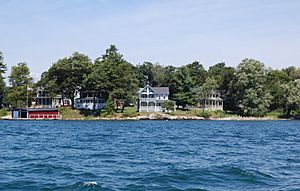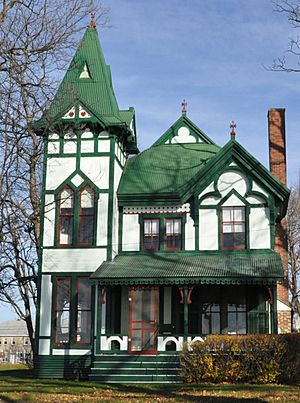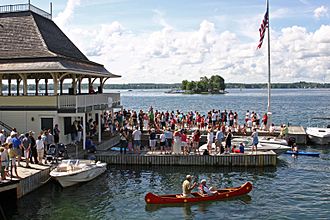Thousand Island Park, New York facts for kids
Quick facts for kids
Thousand Island Park, New York
|
|||||||||||||||||||||||||||||
|---|---|---|---|---|---|---|---|---|---|---|---|---|---|---|---|---|---|---|---|---|---|---|---|---|---|---|---|---|---|

Victorian homes typical of the Thousand Island Park community on the southwest tip of Wellesley Island
|
|||||||||||||||||||||||||||||
| Country | United States | ||||||||||||||||||||||||||||
| State | New York | ||||||||||||||||||||||||||||
| County | Jefferson | ||||||||||||||||||||||||||||
| Town | Orleans | ||||||||||||||||||||||||||||
| Area | |||||||||||||||||||||||||||||
| • Total | 0.63 sq mi (1.63 km2) | ||||||||||||||||||||||||||||
| • Land | 0.30 sq mi (0.77 km2) | ||||||||||||||||||||||||||||
| • Water | 0.33 sq mi (0.86 km2) | ||||||||||||||||||||||||||||
| Elevation | 275 ft (84 m) | ||||||||||||||||||||||||||||
| Population
(2020)
|
|||||||||||||||||||||||||||||
| • Total | 96 | ||||||||||||||||||||||||||||
| • Density | 323.23/sq mi (124.89/km2) | ||||||||||||||||||||||||||||
| Time zone | UTC-5 (Eastern (EST)) | ||||||||||||||||||||||||||||
| • Summer (DST) | UTC-4 (EDT) | ||||||||||||||||||||||||||||
| ZIP code |
13692
|
||||||||||||||||||||||||||||
| Area code(s) |
|
||||||||||||||||||||||||||||
| FIPS code | 36-73726 | ||||||||||||||||||||||||||||
| GNIS feature ID | 0967447 | ||||||||||||||||||||||||||||
|
|||||||||||||||||||||||||||||
Thousand Island Park, also known as TI Park, is a small community in New York. It is located in Jefferson County, within the town of Orleans. You can find it in the beautiful Thousand Islands region, right on the St. Lawrence River.
This place was started in 1875 as a summer vacation spot. Even today, it's mostly a seasonal community where people come to enjoy the warmer months. While it has many houses, only a few people live there all year round.
Thousand Island Park is also a special historic district. It was added to the National Register of Historic Places in 1982. This means it has many old buildings from the late 1800s and early 1900s that are still in great shape. The community is also home to Vivekananda Cottage, a sacred place for followers of the Hindu faith.
Contents
Where is Thousand Island Park?
Thousand Island Park is located in the northern part of the town of Orleans. It sits on the southwest tip of Wellesley Island, which is one of the biggest islands in the Thousand Islands chain. Just to its east, you'll find Wellesley Island State Park.
You can reach the community by car using County Route 100. This road connects to Interstate 81 about 2.5 miles away. The total area of Thousand Island Park is about 0.76 square kilometers, and it's all land.
A lighthouse called Rock Island Light is about 0.5 miles southeast of Thousand Island Park. It's in the middle of the St. Lawrence River's south channel. On the mainland, directly across the water, is Fishers Landing, about 1 mile southeast.
How Many People Live Here?
According to the 2020 US Census, the population of Thousand Island Park was 96 people.
| Historical population | |||
|---|---|---|---|
| Census | Pop. | %± | |
| 2020 | 96 | — | |
| U.S. Decennial Census | |||
A Look Back in Time
The Golden Era: 1875–1912
Thousand Island Park was founded in 1875 by Rev. J.F. Dayan. It began as a summer camp for Methodists, similar to a Chautauqua community. The main idea was to give families a nice, cool, and healthy place to spend their summers. Religious activities were also part of the plan.
At first, people stayed in tents. Soon, this "tent city" grew into a village with permanent summer homes. The main meeting place was the Tabernacle, located at the head of the Park. This building was a hub for social events and educational programs. People could attend religious studies, Sunday school, outdoor activities, and lectures.
Early cottages were often built like wooden tents. Owners got creative, adding unique designs and fancy decorations. As the community grew, larger homes became popular. Many of these Victorian cottages showed off different styles from the 1800s. These included Gothic Revival, Eastlake, Stick, Shingle, and Queen Anne styles. After a big fire in 1912, new styles like Bungalow/Craftsman and Neoclassical Revival were also added.
By 1890, the Park was thriving with almost 600 cottages and 7,000 summer residents. Rules became a bit more relaxed, allowing for more of a resort feel. The Pavilion was the main entrance, where steamships would drop off hundreds of visitors. These visitors came for learning and fun through the Chautauqua programs.
The "Golden Era" ended with a major fire in 1912. This fire destroyed The Columbian, the Park's last big hotel, along with 99 cottages and the main business area.
Mid-century Changes: 1913–1974
After the 1912 fire, families still came to the Park for summer. However, tourism in the region slowly decreased. During the Great Depression, fewer than half of the cottages were used. About 200 cottages were even torn down.
In 1933, the Thousand Island Park Association faced money problems. Its property was sold to a new group called Wellesley Island Park Inc. TI Park continued to decline over the next 20 years. Most hotels closed, and more cottages were removed. By 1950, there were only 12 businesses and 320 cottages, compared to 600 in the late 1800s. The park's ownership changed again in 1953 to the Thousand Island Park Corporation. Families still enjoyed the park in the summer, and by the 1960s and 70s, it became less focused on religion.
Historic Preservation and Revival: 1975–Present
In 1975, the Park celebrated its 100th birthday. This event helped people appreciate its unique charm and architecture again. The celebration led to the creation of the Landmark Society in 1976. This group worked to help the Park regain its historic look. In 1982, their efforts paid off when Thousand Island Park was added to the National Register of Historic Places. Today, the Landmark Society continues to protect the Park's history.
Restoring and preserving TI Park continued into the 2000s. In 2014, another serious fire occurred. It burned down a building at the community's main intersection. This building housed a grocery store, the volunteer fire department, shops, offices, and the post office. A smaller replacement building was rebuilt and opened in 2017.
Swami Vivekananda's Visit
In 1895, a famous Indian spiritual leader named Swami Vivekananda spent seven weeks in Thousand Island Park. He is known for bringing vedanta and yoga ideas to the Western world.
Swami Vivekananda stayed with an American follower in her cottage. This visit was a break after his two-year tour of America. He had given a famous speech at the 1893 Parliament of the World's Religions. While in the Park, he gave talks to his followers from the Vedanta Society. These talks were later put into a book called Inspired Talks. He also wrote poems like "The Song of the Sannyasin".
In 1947, Swami Vivekananda's followers bought the cottage where he stayed. They named it the Vivekananda Cottage. Today, the Ramakrishna-Vivekananda Center owns and runs it. They hold classes and retreats there during the summer. The cottage has become a Hindu sacred site. In 1995, a plaque was put up to celebrate 100 years since Swami Vivekananda's arrival.
Famous People Connected to TI Park
- Abbie Hoffman (1936–1989) – An activist who lived nearby in the late 1970s.
- Abhayananda (b. 1842) – An American monk who visited in 1895.
- George N. Kennedy (1822–1901) – A New York state senator who passed away here.
- Sister Christine (1866–1930) – An American student of Swami Vivekananda who visited in 1895.
- Swami Vivekananda (1863–1902) – An Indian monk and philosopher who visited and gave lectures in 1895.
See also
 In Spanish: Thousand Island Park (Nueva York) para niños
In Spanish: Thousand Island Park (Nueva York) para niños




